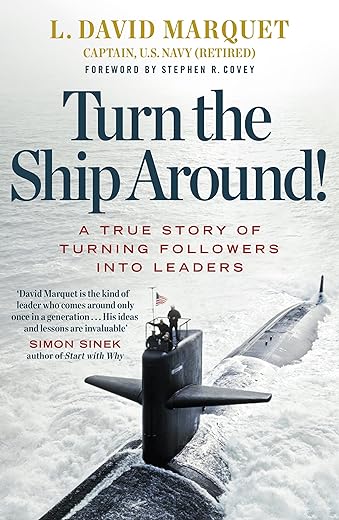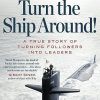Turn The Ship Around!: A True Story of Turning Followers into Leaders
£1.99
‘David Marquet is the kind of leader who comes around only once in a generation . . . his ideas and lessons are invaluable’ Simon Sinek, author of Start With Why
Captain David Marquet was used to giving orders. In the high-stress environment of the USS Santa Fe, a nuclear-powered submarine, it was crucial his men did their job well. But the ship was dogged by poor morale, poor performance and the worst retention in the fleet.
One day, Marquet unknowingly gave an impossible order, and his crew tried to follow it anyway. He realized he was leading in a culture of followers, so he upended the traditional leadership model and put control in the hands of his crew. Before long, his team became fully engaged and the Santa Fe skyrocketed from worst to first in the fleet.
No matter your business or position, you can apply Marquet’s approach to create a workplace where everyone takes responsibility for their actions, people are healthier, happier – and everyone is a leader.
___________________________________________________________________________________
WHAT READERS ARE SAYING ABOUT TURN THE SHIP AROUND:
‘I have bought this book for my entire senior team’ Amazon Review
‘Putting in place the ideas and practices has transformed my work life balance, engaged my teams and improved performance’ Amazon Review
‘Love this book. The most practical actionable advice I can remember reading’ Amazon Review
‘As an owner of a small business I found Marquet’s book inspirational’ Amazon Review
IN HIS LATEST BOOK, LEADERSHIP IS LANGUAGE, MARQUET BUILDS ON HIS TEACHING, SHOWING US HOW TO LEAD OUR TEAMS TO SUCCESS THROUGH THE LANGUAGE THAT WE USE.
Read more
Additional information
| Publisher | Penguin (8 Oct. 2015) |
|---|---|
| Language | English |
| File size | 2881 KB |
| Text-to-Speech | Enabled |
| Enhanced typesetting | Enabled |
| X-Ray | Enabled |
| Word Wise | Enabled |
| Sticky notes | On Kindle Scribe |
| Print length | 233 pages |










by Matthew H.
Brilliant book around the way to empower your team by giving them control, making sure there is a solid base of competence and clarity. Anyone who is or aspires to be a successful leader should read this book!
by JFG
Thai is a good book with clear useful ideas. We are going to use it as a “book club” theme at work.
“I intend to …” is now being played back to me.
A good antedate for micromanagement.
by carlos h.
Great to read, enjoyable and full of content! The book is well structured and that makes you want to read it all in one go.
by Justin mc Guinness
Good read although gets a bit repetitive
by MERLIN
The structure of the book (short chapters, clear progression, list of learning and actionable points) makes for an excellent read and allows one’s mind to free itself from the classic leadership approach. As much as it could be challenging to directly translate the leadership method from a nuclear submarine to one’s specific organisation, the applied nature of the narrative and numerous concrete examples in this book makes for a great first step in the world of leader-leader structure. I will keep pondering about this book for some times after having read it (several times).
by Nathan
On the theme of leadership and psychology safety, this book came highly recommended.
The core takeaway of the book is that anyone can be a leader, which is documented through the crew’s transformation from the worst performing to best within the fleet.
Marquet’s honest appraisal of his strengths and weaknesses as a leader make this a very easy read. The chapters are short, insightful and pack takeaways that draw clear lessons for any industry to adopt- driving a structure from leader-follower to leader-leader.
The change from continually seeking permission for actions to stating “I intend to”, to communicate intentions and verbalising thought process, promoted a culture of trust and empowerment amongst staff. Whilst also improving communications with the team.
A subtle semantics change, but pivotal none the less.
Encouraging and fostering a culture of curiosity was especially pertinent as a mechanism for clarity and continual improvement- highlighted in the team’s engagement with CPD and inspections that led to improvements in academic and professional performance.
“Don’t Brief, Certify” was relevant to pre shift briefings and toolbox talks I have witnessed, with staff encouraged to present their area of expertise and brief the team. To promote ownership and engagement.
This is in contrast to the traditional briefings from a senior member of staff that staff dutifully attend, rather than actively engage with.
This provides efficiencies and benefit from the meetings- tying into the pragmatic approach Marquet also took with ammending antiquated business processes that didn’t serve a contemporary process for his team.
by Mr. Ross Maynard
If you can change the leadership culture on a navy submarine then you can do it anywhere. That is the inspiring thought that David Marquet gives us in this entertaining and very readable account.
With commendable honesty, Mr Marquet details the trials and tribulations that he, and his colleagues, went through on the way to a high performing culture. He didn’t start out with a grand plan or theory – they tried stuff out along the way and gradually found out what worked.
At the high level, what works is that the “leader-leader” model involves giving employees control over what they work on and how they work. This means letting them make meaningful decisions and it requires competence and role clarity. Control, competence and clarity make up the framework that Mr Marquet structures his book on. Within these three pillars Marquet identifies key lessons and actions.
These lessons and structures are not particularly new – I remember studying similar concepts in leadership 25 years ago, and Mr Marquet’s ideas are similar to Servant Leadership and related approaches. What makes this book different – and valuable – is that the author focuses on practicality. He never references theories or research, he simply gets on with the job of trying to change things, pretty much by trial and error. It is this practical approach which will be of most interest to business readers.
I do have some criticisms of the book, notably that Mr Marquet is rather vague in his explanations of how some of his ideas work, or whether they might work outside of the military context. For example, the “I intend to” approach works in a military environment where the leader affirms every action in a control room setting, but I don’t see how it works in a distributed business.
Similarly, I am unclear what “deliberate action” actually means in practice. Vocalising your actions out aloud (if that is what it is) might not be appropriate in a civilian situation and, it seems to me, has as much scope for error as the “old” way – colleagues will soon subconsciously tune-out.
Nevertheless the book remains a useful pointer to a better way than that many of us are accustomed to. It contains some nice ideas for workshops with managers and, above all, its focus on practicality and taking a step-by-step approach make it most useful. There are things here that managers at all levels can start to try out to get the ball rolling.
The key lesson from the book, for me is – to quote – “Don’t move information to authority. Move authority to the information”.
by ethelthered
I want to give this to all my colleagues!
One of the best books I’ve read in years. I recommend it to everyone I meet.